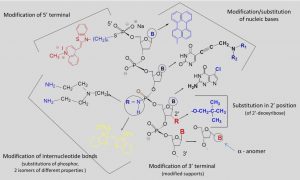Novel families of original oligonucleotides have been recently developed to provide tools for basic research, in vitro diagnostics, biological imaging, and potential therapeutic agents. Depending on applications, the oligonucleotides must possess several of the following properties: forming specific and stable complexes with their targets, inducing irreversible modifications of the targets by bridging or cleavage, producing a modified signal in the presence of targets that can be used as evidence interaction. Moreover, in the case of applications in cell culture and in vivo, they must be stable towards nucleases and be capable of reaching their targets inside cells (J. Gene Med. 2014, 16, 157-165). In order to confer specific properties to the oligonucleotides for targeted applications, we chemically modify their structural elements (nucleic bases, sugars, inter-nucleotide linkages (length and nature)). To these oligonucleotides may be attached various ligands: intercalating and/or reactive molecules, peptides, lipophilic molecules, inhibitors, detectable fluorescent markers.

